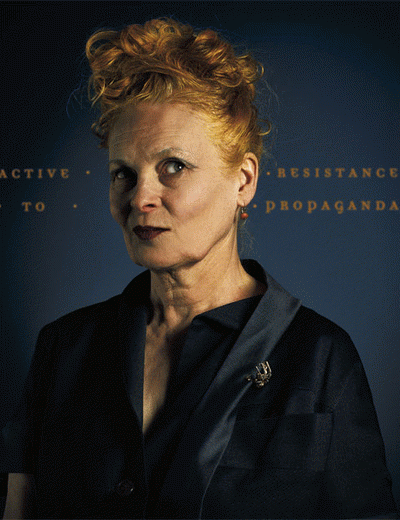Vievienne Westwood, born Vivienne Isabel Swire in Tintwhistele, was born on April 8, 1941. Her father was a shoemaker and her mother a cotton weaver. She is an English fashion designer largely responsible for modern punk and New Wave music new wave fashions. Linked with the Sex Pistols via Malcolm McLaren & their “Sex” boutique on King’s Road, in London during the 1970s.
When she was seventeen, her parents bought a post office and moved to London. There Vivienne went to a teacher training college and then taught at a primary school in North London.
She met her first husband Derek Westwood in 1962 and married him. They had a son Ben. Their marriage lasted three years before she met Malcolm McLaren who became her partner in fashion as well as live, later known for being the manager for punk band The Sex Pistols. Westwood and McLaren had a son named Joseph, and Vievienne continued to teach until 1971, when Malcolm decided to open a shop, ‘Sex’, and this is where Vivienne began to sell her outrageous designs. Another shop was open in the same year together with McLaren, she started up a shop called “Let it Rock” on London’s trendy Kings Road. She spent all nicht stitching rock-inspired clothes, visiting punk clubs and grunge bars. During this period, Westwood, McLaren, and Jamie Reid were influenced by the Situationists. The punk style came to life when the Sex Pistols wore clothes form Westwood and McLaren’s shop at their first gig. The ‘punk style’ included BDSM fashion, bondage gear, safety pins, razor blades, bicycle or lavatory chains on clothing and spiked dog collars that were used as jewellery as well as the outrageous make-up and hair. Together, Vivienne and McLaren revolutionised fashion and the impact is still felt today.
In 1980 there was a change of name to “World’s End” and Vivienne introduced her Pirate collection, including frilly shirts and romantic swashbuckling styles. Vivienne’s first runway show was the Pirate collection in London, March 1981. Her design style had evolved so that her main interests included not only the youth and street culture but also tradition and technique. Vivienne worked historical factors into her collection by using historical 17th-18th century original cutting principles and modernising them. This collection was all about 'gold and treasure, adventure and exploration'.
1982 She introduced the first collection in her own name which proved very popular. Her collections were called Buffalo, Savage, and Punkature.
1983 She gave a fashion show in Paris, the first British designer to do so since Mary Quant in the 60's. People remember it as one of the best shows ever, but chic Parisiennes were horrified by the riotous behaviour and punky London garments. The collection was called "Punkature".
Her relationship with McLaren ended and her shops closed but her talent could not be kept down. She opened a studio in London's Camden area, a 19 km bicycle ride from her modest apartment in South London.
1984 Her collection was called Hypnos, the first sports collection with fluorescent fabrics on the catwalk. 1985 Vivienne Westwood based her collection on Clint Eastwood, the film star. 1985 She launched her "mini-crini" a very short crinoline design, which took off like a rocket. 1992 She was awarded an O.B.E. and went to receive it from the Queen in a see-through blouse, and a skirt which when swirled around displayed her lack of underwear. She shocked the world.
2000 Vivienne Westwood has become the "old lady of fashion" not yet completely respectable, but yet respected. In December 2003, she and the Wedgwood pottery company launched a series of tea sets featuring her designs.
In honour of her 34 year career as well as her 63rd birthday, the Victoria and Albert Costume Institute in London is holding a retrospective of Vivienne's great clothes from April to July 2004. She has moulded modern attitude to the female form all her life and this is the chance to view many of her pioneering styles. A book has also been published of the clothes shown at the exhibition. Vivienne's third husband is Andreas Kronthaler, born in 1966, and so 25 years younger than she is. However, it appears to be a very happy match and she credits him with having a wonderful influence on her life and creativity.
the label
She has the “Gold Label” - her demi couture line of ready-to-wear and made to measure pieces, “Red Label” - her sassy tailoring, knits and shirts and “Man”, her menswear line. Together they have a turnover of 20 million pounds per year.
She supplies 550 stores in 30 countries which is all solely owned by Vivienne herself. Her managing director is carlo D'Amario. Her son Joe Corre operates her World's End Shop, and has turned it into a lucrative label. He assists her with all the chores she has to manage to keep her empire operating. He also owns the lingerie label Agent Provocateur.
